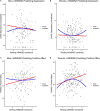Gender Matters: Nonlinear Relationships Between Heart Rate Variability and Depression and Positive Affect
- PMID: 34054402
- PMCID: PMC8155374
- DOI: 10.3389/fnins.2021.612566
Gender Matters: Nonlinear Relationships Between Heart Rate Variability and Depression and Positive Affect
Abstract
Vagally mediated heart rate variability (vmHRV), a measure of the parasympathetic nervous system's control over the heart, is often negatively related to maladaptive emotional outcomes. Recent work suggests that quadratic relationships involving these factors may be present; however, research has not investigated gender differences in these nonlinear functions. To address this gap, the current study tested for quadratic relationships between resting vmHRV and depression and positive affect while investigating gender differences in these relationships. Significant quadratic effects were found between resting vmHRV and reports of both depression symptoms and positive affect in women but not men. Specifically, the lowest levels of depression and the highest levels of positive affect were found at moderate vmHRV in women. These results suggest that examinations of vmHRV's nonlinear associations require the consideration of gender. Our findings are interpreted based on proposed differential neuropsychological mechanisms of vmHRV in men versus women.
Keywords: autonomic nervous system; depression; emotion; gender; gender differences; heart rate variability; nonlinear; positive affect.
Copyright © 2021 Spangler, Dunn, Aldao, Feeling, Free, Gillie, Vasey, Williams, Koenig and Thayer.
Conflict of interest statement
The authors declare that the research was conducted in the absence of any commercial or financial relationships that could be construed as a potential conflict of interest.
Figures

Similar articles
-
A sex-specific pathway linking early life maltreatment, vagal activity, and depressive symptoms.Eur J Psychotraumatol. 2024;15(1):2325247. doi: 10.1080/20008066.2024.2325247. Epub 2024 Mar 21. Eur J Psychotraumatol. 2024. PMID: 38512074 Free PMC article.
-
Gender moderates the association between resting vagally mediated heart rate variability and attentional control.Front Psychiatry. 2023 Aug 16;14:1165467. doi: 10.3389/fpsyt.2023.1165467. eCollection 2023. Front Psychiatry. 2023. PMID: 37654989 Free PMC article.
-
Resting heart rate variability predicts self-reported difficulties in emotion regulation: a focus on different facets of emotion regulation.Front Psychol. 2015 Mar 10;6:261. doi: 10.3389/fpsyg.2015.00261. eCollection 2015. Front Psychol. 2015. PMID: 25806017 Free PMC article.
-
Vagally-mediated heart rate variability and depression in children and adolescents - A meta-analytic update.J Affect Disord. 2023 Oct 15;339:237-255. doi: 10.1016/j.jad.2023.07.027. Epub 2023 Jul 10. J Affect Disord. 2023. PMID: 37437729 Review.
-
Resting state vagal tone in borderline personality disorder: A meta-analysis.Prog Neuropsychopharmacol Biol Psychiatry. 2016 Jan 4;64:18-26. doi: 10.1016/j.pnpbp.2015.07.002. Epub 2015 Jul 11. Prog Neuropsychopharmacol Biol Psychiatry. 2016. PMID: 26169575 Review.
Cited by
-
Cardiac Autonomic Balance Is Altered during the Acute Stress Response in Adolescent Major Depression-Effect of Sex.Life (Basel). 2023 Nov 20;13(11):2230. doi: 10.3390/life13112230. Life (Basel). 2023. PMID: 38004370 Free PMC article.
-
Are the ways women cope with stressors related to their health behaviors over time?Ann Behav Med. 2025 Jan 4;59(1):kaaf006. doi: 10.1093/abm/kaaf006. Ann Behav Med. 2025. PMID: 39912382 Free PMC article.
-
Gender Differences in Cardiac Chronotropic Control: Implications for Heart Rate Variability Research.Appl Psychophysiol Biofeedback. 2022 Mar;47(1):65-75. doi: 10.1007/s10484-021-09528-w. Appl Psychophysiol Biofeedback. 2022. PMID: 34817765 Free PMC article.
-
A bioelectronic route to compassion: Rationale and study protocol for combining transcutaneous vagus nerve stimulation (tVNS) with compassionate mental imagery.PLoS One. 2023 Mar 13;18(3):e0282861. doi: 10.1371/journal.pone.0282861. eCollection 2023. PLoS One. 2023. PMID: 36913378 Free PMC article.
-
A sex-specific pathway linking early life maltreatment, vagal activity, and depressive symptoms.Eur J Psychotraumatol. 2024;15(1):2325247. doi: 10.1080/20008066.2024.2325247. Epub 2024 Mar 21. Eur J Psychotraumatol. 2024. PMID: 38512074 Free PMC article.
References
LinkOut - more resources
Full Text Sources
Other Literature Sources
Miscellaneous

